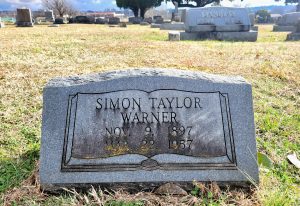By ZOË WATKINS
zwatkins@bedfordcountypost.com
 “Simon Warner of Shelbyville is either uncannily psychic or a super-salesman and don’t ask me which…”
“Simon Warner of Shelbyville is either uncannily psychic or a super-salesman and don’t ask me which…”
Those are the words from a reporter for The Nashville Banner from the April 27, 1939, issue.
Simon Warner’s name floated across the pages of newspapers from Tennessee to New York when he was alive between 1897 until his untimely death in 1957.
And with recent inquiries at the Bedford County Archives, his name is once again floating across the page of the newspaper. Even after 67 years, his name still invokes a sense of the mysterious and the macabre.
Human curiosity of things not easily understood are often what drive people to question legends of the past. And it’s something county archivist Carol Roberts dives into daily.
“Many people are just interested in interesting characters,” said Roberts. “I am honored to be able to help people find the facts that go with the legend and that’s been one of my favorite research things, is to take an oral history project and put the facts with it, not to necessarily confirm or deny it, but to add to it.”
‘Crime Doctor’
Whether you believe in Warner’s psychic abilities or not, it is a fact that Warner assisted sheriff departments in solving missing person cases.
Or at least that’s what the newspapers of the day say.
“He was sort of the finder of lost things,” said Roberts. “His biggest claim to fame was helping the sheriffs with lost things.”
Most notably, in 1941, Warner solved the case of Chapel Hill resident, 41-year-old Lillian Ketchum, who was strangled to death by her boyfriend and local farmer, Robert Skinner, before he committed suicide.
In an article titled “Murder and Suicide Said Solved with Tips from Fortune Teller” from The Nashville Tennessean’s Jan. 19, 1941, edition, it recounts how Sheriff Will Ogilvie said officers with the department approached Simon Warner about Ketchum’s missing body.
Warner, who “gazed into his crystal,” told the officers to look in a brushy area near Skinner’s home in the Flat Creek section of Williamson County.
On Jan. 14, 1941, they did, and about 150 yards from the house, hidden amongst some dead brush, they found Ketchum’s body, frozen stiff, with her neck broken.
When asked how he knew where Ketchum’s body was, Warner responded, “I looked into the crystal and it told me where to tell the man to look. I don’t remember the details…I am just a messenger.”
Warner also predicted to law enforcement of several killings that would take place. In 1936, Warner said he warned the chief of police of Shelbyville to “be careful; that he would be shot.” Sure enough, Warner said the officer was shot within two days.
Visions and crystal balls
Warner was born Nov. 9, 1897. There aren’t many archived photos of Warner — just grainy newspaper shots of a man with a broad forehead and dark eyes framed by circular-rimmed glasses.
In an article from The Nashville Banner from Jan. 25, 1941, “It was the bite of a rattlesnake that gave Simon T. Warner, Shelbyville fortune teller, the ability to read the crystal ball, he said here today.”
Snake or not, Warner’s mother, Susie E. Warner, said that he was the youngest of six children and “a peculiar one,” as described in a New York magazine’s Sunday read from Feb. 23, 1941.
“I don’t ever know what my boy’s thinking about,” she said in the article.
This also grated on Warner’s first wife, Nannie Lou Underwood, who divorced Simon on grounds that she didn’t want “to live any longer with a man who reads my mind.”
Whatever he was thinking, it didn’t stop him from having seven children with her, all of whom she left behind to go live in Texas. According to Ancestry.com, he also had a son, Simon Warner Jr., with a Ruby A. Frazier in 1943.
Warner also ran a city café, which was located at 204 Depot St., which archivists have detected from phone books, which began listing the restaurant starting in 1952.
But when not serving cigars and coffee or gazing into his crystal ball, Warner was also known to have a “Traveling Torture and Crime Museum,” according to old posters from 1947 that Roberts found online on auction sites.
Interested parties could see everything from an eye-gouging chair to solid brass foot and ankle crushers to numerous wax heads.
“He had this idea of business, even this traveling circus show, he was just trying a lot of different things post-World War Two to make a living and just became an interesting character for being able to solve the crimes,” said Roberts. “He was known regionally for helping people.”
Untimely death
But often, great gifts comes with a great price.
On March 22, 1957, Warner was shot in his home, 414 West Lane St., by Mose Martin, a Scottsboro, Ala., man who believed Warner had put a “voodoo” curse on him.
Martin was judged insane and sent to live in a mental hospital in Nashville, according to court records.
Simon Warner today
Today, Warner’s body rests beside his parents in Willow Mount Cemetery. Sexton Ben Chapman said people every year come to visit the gravesite. In fact, Chapman said two women from Texas who wanted to be psychics came to Warner’s grave to “ask him permission” to be seers.
Chapman added that even FBI and law enforcement officers have even come to visit the grave.
One can guess, in a way, Warner has become his own posthumous curiosity show for those seeking the mysterious, making the legend live on.



![For-Tips-and-Ideas-Phone-300x250-Bedford-County-Post[1]](https://www.bedfordcountypost.com/wp-content/uploads/2023/09/For-Tips-and-Ideas-Phone-300x250-Bedford-County-Post1-300x250.jpg)
![Subscribe-Now-300x250-Bedford-County-Post[1]](https://www.bedfordcountypost.com/wp-content/uploads/2023/09/Subscribe-Now-300x250-Bedford-County-Post1-300x250.jpg)

